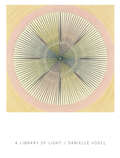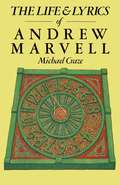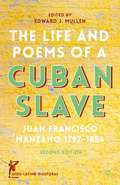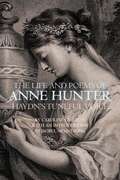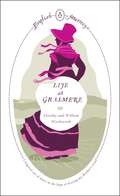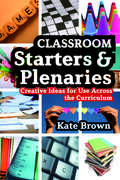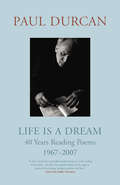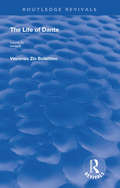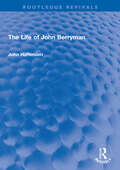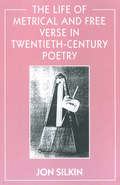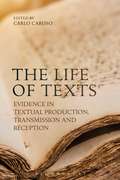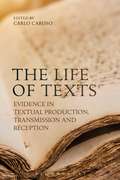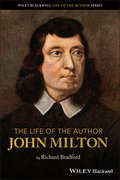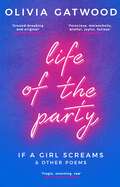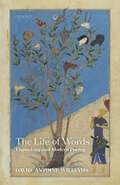- Table View
- List View
Li Bo Unkempt
by Kidder SmithThis is Li Bo. You may also know him as Li Po 李白 (701–62), the great poet of Tang China, master of swoop and soar, wanderer, man of wine, so enamored of the moon that he tried to embrace her reflection in the river, fell from his boat and drowned. Favorite of the Emperor—but only for a while, as such energies cannot be long contained at Court. Li Bo Unkempt presents seventy of his verses, a few letters, some rhapsodies and songs. They dance all through Tang high culture, inhabited by planets, hermit women, swashbucklers, grottos, calligraphers and buffoons, Li Bo’s friends, lovers and alter egos. He’s too shy, too quick to make introductions, but this volume allows us to hear the poetry's stories, their temperaments, to glimpse their secret economies of exchange. The book also offers background material, brief essays, a kind of Lonely Planet™ guidebook to this extraordinary realm. This way the strange will become familiar, and only then can we appreciate how truly strange it is. The authors and translators regard these poems as magical acts. What is offered, then, in this volume, are multiple ways to realize that magic. The essays are demonstrations, a spell-book, an extension of this non-ordinary knowing. Things too delicate to be said directly. So the book proceeds by analogy, by juxtaposition, latency, innuendo, jump cuts, dialetheia and flirt. All this a way to understand a deeper claim: that Li Bo is an immortal. And what might that be...?
A Library of Light (Wesleyan Poetry Series)
by Danielle VogelWhen poet Danielle Vogel began writing meditations on the syntax of earthen and astral light, she had no idea that her mother's tragic death would eclipse the writing of that book, turning her attention to grief's syntax and quiet fields of cellular light in the form of memory. Written in elegant, crystalline prose poems, A Library of Light is a memoir that begins and ends in an incantatory space, one in which light speaks. At the book's center glows a more localized light: the voice of the poet as she reflects, with ceremonial patience, on the bioluminescence of the human body, language's relationship to lineage, her mother's journals written during years of estrangement from her daughter, and the healing potential of poetry. A mesmerizing elegy infused with studies of epigenetic theory and biophotonics, A Library of Light shows that to language is to take part in transmission, transmutation of energy, and sonic (re)patterning of biological light.[sample poem]When we are. When we are there, we lay together and cover ourselves with our voices. When we are ten, we are also twenty-one. We speak of breathing, but this is a thing we cannot do. When we are seven, we are also eighteen. When we are eighteen, we begin our bodies. But we are unmappable,unhinged. A resynchronization of codes, thecrystalline frequencies of stars, seeds, vowels, lying dormant within you. We are the oldest dialect. Asound the voice cannot make but makes.
Life: The beautifully illustrated natural history book for kids
by Elli Woollard“While up in the air, warm and bright, Feathery creatures with wings took flight.Soaring high in the blissful breeze,And deep in the wind whipped waves of the seas.”From tiny dots of microscopic bacteria to enormous dinosaurs.Through the Ice Ages and the gallop of evolution.From cavemen to cars, discover how our world began.Elli Woollard's lyrical text is a pitch-perfect blend of storytelling, science and wonder. Life will fascinate and entertain the curious child, with Dorien Brouwers' immersive artwork heightening the beauty and inspiring awe in readers young and old.
The Life and Loves of Laurie Lee
by Valerie GroveMillions of readers know and love him for his lyrical portraits of his life, from the moving and nostalgic tales of childhood and innocence found in the pages of Cider with Rosie, to the nomadic wanderings through Spain retold in As I Walked Out One Midsummer Morning, to his dramatic experiences fighting Franco's forces in A Moment of War. As a poet, playwright, broadcaster and writer, Laurie Lee created a legend around himself that would see him safely secured in the literary canon even within his own lifetime. Yet, though he wrote exclusively about his own life, Lee never told the whole story. His readers know him as a man devoted to two women: his wife and his daughter, 'the firstborn'. Among the pages of his published works there is little trace of the girls he left behind. He never identifi ed in print the girl who inspired him to go to Spain, or the woman who supported him there. He never named the beautiful mistress he came home to, who was the great love of his young life and who led him into literary London, bore his child and broke his heart. In The Life and Loves of Laurie Lee, acclaimed biographer Valerie Grove delves into the letters and diaries he kept hidden from the world, building on her magisterial study of the charismatic poet to capture the essence of this romantic, elusive enigma and bring him to life once more.
The Life and Poems of a Cuban Slave: Juan Francisco Manzano 1797–1854 (Afro-Latin@ Diasporas)
by J. ManzanoThis is a revised second edition of Edward Mullen's landmark scholarly presentation of Juan Francisco Manazo's autobiography and poetry. Taking into account the extensive scholarship that has accrued in the intervening decades, this is an accessible, essential resource for scholars and students of Caribbean literatures.
The Life and Poems of Anne Hunter: Haydn’s Tuneful Voice (Liverpool English Texts and Studies #56)
by Caroline GrigsonAnne Home Hunter (1741-1821) was one of the most successful song writers of the second half of the eighteenth century, most famously as the poet who wrote the lyrics of many of Haydn’s songs. However her work, which included many more serious, lyrical and romantic poems has been largely forgotten. This book contains over 200 poems, some published in her life-time under her married name ‘Mrs John Hunter’, some attributed only to ‘a Lady’, and most importantly many transcribed from her manuscripts, housed in various archives and in a private collection, which are now collected for the first time. Hitherto Anne Hunter has been known almost entirely through her ‘Poems’ published in 1802, in her Introduction Isobel Armstrong argues that she saw this book as a definitive representation of her poetry. Besides her consummately skilful lyrics and songs it contains serious political odes and reflective poems. The unpublished material amplifies and extends the work of 1802. The introduction is followed by a long biographical essay by Caroline Grigson. The daughter of Robert Home, an impoverished Scottish Army surgeon, Anne Hunter spent her adult life in London where she married the famous anatomist John Hunter, with whom she lived in great style, latterly as a bluestocking hostess, until his death in 1793. The book includes many new details of her long life, her friendship with Angelica Kaufman (who painted her portrait - see cover) and the bluestocking, Elizabeth Carter. The account of Anne’s life as a widow describes her relationships with her family, her niece the playwright Joanna Baillie, and her friends, especially those of the famous Minto family, as well as the Scottish impresario George Thomson. Of especial interest is the discovery of a previously unrecorded visit that Haydn made to her during his second London visit when she was living in Blackheath. Expertly researched which Grigson’s book sets Anne Hunter’s oeuvre in the political and social context of the time and will be required reading to scholars of literature and music alike.
Life At Grasmere
by Dorothy WordsworthThe beautiful and peaceful heart of the Lake District, Grasmere was an inspiration to both Dorothy and William Wordsworth. Hills, lakes and orchards, letter writing, walks and welcome visitors (including fellow poet Samuel Taylor Coleridge) provoked in Dorothy's journal great, lyrical prose, which in turn influenced her brother's unsurpassed poetry. The two - journal entries and poems - are here set side by side, a glorious celebration of life and nature around Dove Cottage, over the first year they called it home.Generations of inhabitants have helped shape the English countryside - but it has profoundly shaped us too.It has provoked a huge variety of responses from artists, writers, musicians and people who live and work on the land - as well as those who are travelling through it.English Journeys celebrates this long tradition with a series of twenty books on all aspects of the countryside, from stargazey pie and country churches, to man's relationship with nature and songs celebrating the patterns of the countryside (as well as ghosts and love-struck soldiers).
The Life in the Sonnets (Shakespeare Now!)
by David FullerA passionately argued account of the value of experience and emotion in reading Shakespeare's sonnets and of the importance of reading poetry aloud.
Life is a Dream: 40 Years Reading Poems 1967-2007
by Paul DurcanFamous for his electrifying poetry readings, Paul Durcan marks four decades of composing silently and reciting aloud with this magnificent collection, which brings together for the first time the critically acclaimed poet's own choice of his work from his first book, Endsville (1967), to The Laughter of Mothers (2007). Life is a Dream represents the whole range of Durcan's writing - funny and subversive verse narratives and self-mocking poems of underachievement; poems celebrating love and sex or the lives of famous writers and artists; as well as tender, poignant verses commemorating the dead. Throughout his long career, Durcan has continued to make passionate and moving poetry out of his own and his country's misfortunes. He is by turns a surrealist, a mystic, an Irish comedian with perfect comic timing and an angry champion of the oppressed. Life is a Dream reaffirms the constant vision and artistic integrity of one of the most powerful, humane and original voices in modern poetry.
The Life of Dante (Routledge Revivals)
by Giovanni BoccaccioPublished in 1990: This book tells the life story of Dante, the poet and his work.
The Life of Dante (Routledge Revivals)
by Giovanni BoccaccioPublished in 1990: This book tells the life story of Dante, the poet and his work.
The Life of John Berryman (Routledge Revivals)
by John HaffendenFirst published in 1982, The Life of John Berryman draws on extensive research in the USA and on an enormous collection of hitherto unpublished materials – journals, letters, stories and poetry –to build a biography that recounts in absorbing detail the public and private stages of John Berry man’s career. It also offers an intimate portrait of a creative artist: his compulsive self-presentation and self-reproach, his moral and artistic dilemmas, his dedication and his accomplishments. John Berryman occupies a central place among the outstanding poets of recent times. The course of his life ran between the extremes of personal degradation and artistic ecstasy. He suffered the early suicide of his father, the dominance of his mother, poverty and professional setbacks, psychiatric treatment, alcoholism, and sexual and spiritual vexation. He became an electrifying, fearful teacher and a loving, jealous friend. His mentors and close associates included Mark Van Doren, Richard Blackmur, Allen Tate, Robert Lowell and Saul Bellow. The years brought him spells of deep personal joy and artistic fulfilment, but all too heavy a hand of terrible suffering. The book will be an extremely interesting read for students of literature.
The Life of John Berryman (Routledge Revivals)
by John HaffendenFirst published in 1982, The Life of John Berryman draws on extensive research in the USA and on an enormous collection of hitherto unpublished materials – journals, letters, stories and poetry –to build a biography that recounts in absorbing detail the public and private stages of John Berry man’s career. It also offers an intimate portrait of a creative artist: his compulsive self-presentation and self-reproach, his moral and artistic dilemmas, his dedication and his accomplishments. John Berryman occupies a central place among the outstanding poets of recent times. The course of his life ran between the extremes of personal degradation and artistic ecstasy. He suffered the early suicide of his father, the dominance of his mother, poverty and professional setbacks, psychiatric treatment, alcoholism, and sexual and spiritual vexation. He became an electrifying, fearful teacher and a loving, jealous friend. His mentors and close associates included Mark Van Doren, Richard Blackmur, Allen Tate, Robert Lowell and Saul Bellow. The years brought him spells of deep personal joy and artistic fulfilment, but all too heavy a hand of terrible suffering. The book will be an extremely interesting read for students of literature.
The Life of Mark Akenside: The Breakthrough to Modernity
by Barbara C. MordenMark Akenside (1721–1770) was a medical doctor and literary man whose influence on the history of ideas was profound.Born the son of a butcher in Newcastle Upon Tyne in 1721 Mark Akenside was awarded a degree in medicine from Edinburgh and Leyden Universities. He settled in London in 1743 where he was successful both as a doctor and in medical research. Above all, he was the author of The Pleasures of Imagination1744, an epic length poem in blank verse which broke many conventions of the time, exploring ideas about human perception and the natural world.Akenside had a European reputation and became a national celebrity. He was a major influence on first- and second-generation Romantic poets such as Wordsworth, Keats, Coleridge, etc. He also made an impact on the development of landscape painting in the early 19th century through his influence on J.M.W. Turner.This book examines these issues, as well as the controversy and speculation about Akenside’s relationship with his origins, his sexuality, and changing political affiliations in a period of economic crisis and great social change.
The Life of Metrical and Free Verse in Twentieth-Century Poetry
by Jon SilkinIn a wide-ranging and compelling account of the life of metrical and free verse in the twentieth century, poet and critic Jon Silkin deepens our understanding of the way poetry works on us. He begins from the premiss that two modes of verse, free and metrical, engage the creative energies of poetry now, creating a rich, fertile environment capable of yielding work valuable to poetry itself and to the society which has given it life. With a practitioner's empathy Silkin reads the poetry of Whitman, Hopkins, Eliot, Pound, Lawrence, Dylan Thomas, Bunting and eight British poets from the post-second World War period to illustrate how free and metrical verse create, separately or together, a poetic harmony. Additionally, he includes crucial statements on modern poetry from poets themselves, concluding with a fine memoir of Basil Bunting by Connie Pickard, published in book-form for the first time.
The Life of Texts: Evidence in Textual Production, Transmission and Reception
by Carlo CarusoThe textual foundations of works of great cultural significance are often less stable than one would wish them to be. No work of Homer, Dante or Shakespeare survives in utterly reliable witnesses, be they papyri, manuscripts or printed editions. Notions of textual authority have varied considerably across the ages under the influence of different (and differently motivated) agents, such as scribes, annotators, editors, correctors, grammarians, printers and publishers, over and above the authors themselves. The need for preserving the written legacy of peoples and nations as faithfully as possible has always been counterbalanced by a duty to ensure its accessibility to successive generations at different times and in different cultural contexts.The ten chapters collected in this volume offer critical approaches to such authors and texts as Homer, the Bible, The Thousand and One Nights, Dante, Montaigne, Shakespeare, Eliot, but also Leonardo da Vinci's manuscripts uniquely combining word and image, as well as Beethoven's 'Tempest' sonata (Op. 31, No. 2) as seen from the angle of music as text. Together the contributors argue that an awareness of what the 'life of texts' entails is essential for a critical understanding of the transmission of culture.
The Life of Texts: Evidence in Textual Production, Transmission and Reception
by Carlo CarusoThe textual foundations of works of great cultural significance are often less stable than one would wish them to be. No work of Homer, Dante or Shakespeare survives in utterly reliable witnesses, be they papyri, manuscripts or printed editions. Notions of textual authority have varied considerably across the ages under the influence of different (and differently motivated) agents, such as scribes, annotators, editors, correctors, grammarians, printers and publishers, over and above the authors themselves. The need for preserving the written legacy of peoples and nations as faithfully as possible has always been counterbalanced by a duty to ensure its accessibility to successive generations at different times and in different cultural contexts.The ten chapters collected in this volume offer critical approaches to such authors and texts as Homer, the Bible, The Thousand and One Nights, Dante, Montaigne, Shakespeare, Eliot, but also Leonardo da Vinci's manuscripts uniquely combining word and image, as well as Beethoven's 'Tempest' sonata (Op. 31, No. 2) as seen from the angle of music as text. Together the contributors argue that an awareness of what the 'life of texts' entails is essential for a critical understanding of the transmission of culture.
The Life of the Author: John Milton (The Life of the Author)
by Richard BradfordTHE LIFE OF THE AUTHOR An expansive biography of John Milton, including an assessment of his poetry and prose and an account of the ways in which he has been presented over the past three and a half centuries—written by a leading scholar in the fieldIt is hard to overstate the role that John Milton played in the historical, political and literary controversies of seventeenth century England; his writings and very life challenged the status quo. Living through one of the most tumultuous periods in British history, Milton was involved at every turn. Struggling to reconcile his private beliefs with his involvement with a radical political experiment, a republic which involved the killing of the monarch, his star rose and fell several times during his life. Married three times, struck blind at a cruelly early age, he was a famed pamphleteer and political activist whose revolutionary political credos placed him in mortal danger after the Restoration. Milton’s varied life makes for fascinating reading but it also produced some of the most important poetry in the English language. Paradise Lost, the only poem in English recognized as an epic, challenged conventional thinking on widespread topics from religion and gender equality to the fundamental question of why we behave as we do.This fascinating new biography is divided into two parts. The first separates the man from the myth, and elucidates the complicated details of Milton’s life from his early years as a literary artist uncertain of his destiny, through his work as a propagandist for the Cromwellian republic, to his rewriting of the Old Testament story of the Fall as a poetic allegory of more recent history. The second looks at how biographers and critics from the seventeenth century to the present day have distorted and manipulated the personality of Milton to suit their biases. Balancing accessibility with academic rigor, this volume:Examines the significant aspects of Milton’s life and work, including his poetry and prose, his government writings, his travels, and his final yearsExplores Milton’s Protestant and republican influences in Paradise Lost, Paradise Regained, and his other literary worksHighlights the differences and similarities between Milton’s poetry and political proseFollows the history of biographical and critical presentations of Milton from the seventeenth century onwards, including his adoption as a hero of Romanticism and his survival in the twentieth century as, allegedly, a sceptical humanistAddresses modern critiques of Milton in Marxism, Feminism, and other branches of TheoryThe Life of the Author: John Milton. Poet and Revolutionary is essential reading for undergraduate and graduate students, university lecturers, and academic researchers in relevant fields, particularly seventeenth century poetry and history, as well as literary biography and the history of criticism.
The Life of the Author: John Milton (The Life of the Author)
by Richard BradfordTHE LIFE OF THE AUTHOR An expansive biography of John Milton, including an assessment of his poetry and prose and an account of the ways in which he has been presented over the past three and a half centuries—written by a leading scholar in the fieldIt is hard to overstate the role that John Milton played in the historical, political and literary controversies of seventeenth century England; his writings and very life challenged the status quo. Living through one of the most tumultuous periods in British history, Milton was involved at every turn. Struggling to reconcile his private beliefs with his involvement with a radical political experiment, a republic which involved the killing of the monarch, his star rose and fell several times during his life. Married three times, struck blind at a cruelly early age, he was a famed pamphleteer and political activist whose revolutionary political credos placed him in mortal danger after the Restoration. Milton’s varied life makes for fascinating reading but it also produced some of the most important poetry in the English language. Paradise Lost, the only poem in English recognized as an epic, challenged conventional thinking on widespread topics from religion and gender equality to the fundamental question of why we behave as we do.This fascinating new biography is divided into two parts. The first separates the man from the myth, and elucidates the complicated details of Milton’s life from his early years as a literary artist uncertain of his destiny, through his work as a propagandist for the Cromwellian republic, to his rewriting of the Old Testament story of the Fall as a poetic allegory of more recent history. The second looks at how biographers and critics from the seventeenth century to the present day have distorted and manipulated the personality of Milton to suit their biases. Balancing accessibility with academic rigor, this volume:Examines the significant aspects of Milton’s life and work, including his poetry and prose, his government writings, his travels, and his final yearsExplores Milton’s Protestant and republican influences in Paradise Lost, Paradise Regained, and his other literary worksHighlights the differences and similarities between Milton’s poetry and political proseFollows the history of biographical and critical presentations of Milton from the seventeenth century onwards, including his adoption as a hero of Romanticism and his survival in the twentieth century as, allegedly, a sceptical humanistAddresses modern critiques of Milton in Marxism, Feminism, and other branches of TheoryThe Life of the Author: John Milton. Poet and Revolutionary is essential reading for undergraduate and graduate students, university lecturers, and academic researchers in relevant fields, particularly seventeenth century poetry and history, as well as literary biography and the history of criticism.
The Life of the Author: Maya Angelou (The Life of the Author)
by Linda Wagner-MartinTHE LIFE OF THE AUTHOR MAYA ANGELOU DISCOVER THE REMARKABLE LIFE OF MAYA ANGELOU WITH A HIGHLY PERSONAL AND DETAILED ACCOUNT OF HER CHALLENGES AND TRIUMPHS The Life of the Author: Maya Angelou delivers an engaging and thorough retelling of the life and work of the celebrated and accomplished writer, director, and essayist. The book offers readers an engrossing retelling of Maya Angelou’s entire life, from her time as a child in the segregated town of Stamps, Arkansas, to her death in 2014 in Winston-Salem. Written with an emphasis on accessibility, the author avoids critical theory and focuses on Maya Angelou’s growth as a person and writer as well as the ways in which her life influenced her work. This new biography tells the story of a young black woman who overcomes poverty and endemic structural and personal obstacles to lead an accomplished life. Readers will also enjoy: A thorough retelling of the time Maya Angelou spent in Africa and how it shaped her views and work An exploration of the screenplays written by Maya Angelou Discussions of Maya Angelou’s early life as a dancer, singer, and writer Accounts of Maya Angelou’s writing and production of television shows A fulsome treatment of Maya Angelou’s work, including her poems, autobiographies, films, music, and theatre Perfect for undergraduate students in Contemporary Literature courses as well as general readers who love Maya Angelou and her work, The Life of the Author: Maya Angelou will also earn a place in the libraries of biography and literature enthusiasts who seek to improve their understanding of the life and story of Maya Angelou with a highly personal and accessible new book.
The Life of the Author: Maya Angelou (The Life of the Author)
by Linda Wagner-MartinTHE LIFE OF THE AUTHOR MAYA ANGELOU DISCOVER THE REMARKABLE LIFE OF MAYA ANGELOU WITH A HIGHLY PERSONAL AND DETAILED ACCOUNT OF HER CHALLENGES AND TRIUMPHS The Life of the Author: Maya Angelou delivers an engaging and thorough retelling of the life and work of the celebrated and accomplished writer, director, and essayist. The book offers readers an engrossing retelling of Maya Angelou’s entire life, from her time as a child in the segregated town of Stamps, Arkansas, to her death in 2014 in Winston-Salem. Written with an emphasis on accessibility, the author avoids critical theory and focuses on Maya Angelou’s growth as a person and writer as well as the ways in which her life influenced her work. This new biography tells the story of a young black woman who overcomes poverty and endemic structural and personal obstacles to lead an accomplished life. Readers will also enjoy: A thorough retelling of the time Maya Angelou spent in Africa and how it shaped her views and work An exploration of the screenplays written by Maya Angelou Discussions of Maya Angelou’s early life as a dancer, singer, and writer Accounts of Maya Angelou’s writing and production of television shows A fulsome treatment of Maya Angelou’s work, including her poems, autobiographies, films, music, and theatre Perfect for undergraduate students in Contemporary Literature courses as well as general readers who love Maya Angelou and her work, The Life of the Author: Maya Angelou will also earn a place in the libraries of biography and literature enthusiasts who seek to improve their understanding of the life and story of Maya Angelou with a highly personal and accessible new book.
Life of the Party: If A Girl Screams, and Other Poems
by Olivia Gatwood____________"I am stirred by the poems in this book - it is a sharp, unflinching collection of poems about girlhood, wonder, casual everyday violence."Yrsa Daley-Ward, author of 'bone' and 'The Terrible'In this multi-faceted collection of odes, anecdotes, sonnets and prose, Olivia Gatwood weaves together the trials and triumphs of growing up and explores the many ways that fear and violence can be internalized in a woman's psyche. At times blistering and riotous, at times soulful and exuberant, Life of the Party is about what it means to be a girl and a woman in today’s world and the challenge of briefly being both. In powerful, piercingly candid language, Gatwood asks: How does one grow from a girl to a woman in a world wracked by violence? What happens to our bodies that make us who we are? Is this fear really irrational?A dazzling collection of raw and explosive poems from a thrilling new feminist voice.
The Life of Words: Etymology and Modern Poetry
by David-Antoine WilliamsFor centuries, investigations into the origins of words were entwined with investigations into the origins of humanity and the cosmos. With the development of modern etymological practice in the nineteenth century, however, many cherished etymologies were shown to be impossible, and the very idea of original 'true meaning' asserted in the etymology of 'etymology' declared a fallacy. Structural linguistics later held that the relationship between sound and meaning in language was 'arbitrary', or 'unmotivated', a truth that has survived with small modification until today. On the other hand, the relationship between sound and meaning has been a prime motivator of poems, at all times throughout history. The Life of Words studies a selection of poets inhabiting our 'Age of the Arbitrary', whose auditory-semantic sensibilities have additionally been motivated by a historical sense of the language, troubled as it may be by claims and counterclaims of 'fallacy' or 'true meaning'. Arguing that etymology activates peculiar kinds of epistemology in the modern poem, the book pays extended attention to poems by G. M. Hopkins, Anne Waldman, Ciaran Carson, and Anne Carson, and to the collected works of Geoffrey Hill, Paul Muldoon, Seamus Heaney, R. F. Langley, and J. H. Prynne.
The Life of Words: Etymology and Modern Poetry
by David-Antoine WilliamsFor centuries, investigations into the origins of words were entwined with investigations into the origins of humanity and the cosmos. With the development of modern etymological practice in the nineteenth century, however, many cherished etymologies were shown to be impossible, and the very idea of original 'true meaning' asserted in the etymology of 'etymology' declared a fallacy. Structural linguistics later held that the relationship between sound and meaning in language was 'arbitrary', or 'unmotivated', a truth that has survived with small modification until today. On the other hand, the relationship between sound and meaning has been a prime motivator of poems, at all times throughout history. The Life of Words studies a selection of poets inhabiting our 'Age of the Arbitrary', whose auditory-semantic sensibilities have additionally been motivated by a historical sense of the language, troubled as it may be by claims and counterclaims of 'fallacy' or 'true meaning'. Arguing that etymology activates peculiar kinds of epistemology in the modern poem, the book pays extended attention to poems by G. M. Hopkins, Anne Waldman, Ciaran Carson, and Anne Carson, and to the collected works of Geoffrey Hill, Paul Muldoon, Seamus Heaney, R. F. Langley, and J. H. Prynne.

